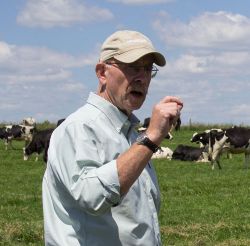 Mike Rankin
Mike Rankin
Apparently, the word is out. The students have been paying attention in their agricultural economics classes, reading the popular press, and/or attending grazing field days where the evils of baling are often conveyed.
But is baling really that bad?
The answer, as is often the case, depends on the situation. There is no denying that grazed forage is cheaper than feeding stored forage. It’s also true that whether a cattleman makes his own bales or buys them, that fact alone doesn’t define profitability.
Perhaps the most relevant point to be made is that maximizing grazing days for the year has greater economic implications than whether you buy or bale hay. The list of tools to accomplish this is well known to most cattle producers: rotational grazing, strip grazing, nitrogen fertilizer, stockpiling, and the strategic use of summer and winter annuals. This is where to start.
Most economic analyses that support the purchase of hay over baling assume that there is a dependable supplier who can deliver what you want and when you want it. Where this situation exists, buying hay may be an easy choice, especially in the South where supplemental forage is needed for 60 days or less. It’s also safe to say that cash flowing a line of hay equipment is easier on a large operation than a small one.
Ultimately, it’s the pastures and cows that will make the money. If making hay compromises the time and management needed for the cattle and their forage, then stay as far away from the baler as possible and find someone else willing and able to supply hay.
If you feed growing and finishing cattle during the nongrazing months, just any hay won’t do. This is one of the reasons I’m often given by operations that make their own hay. More and more, hay is being stored as baleage to further enhance forage quality. With a growing number of grass-fed beef operations, legume-packed baleage is the winter feed of choice. This makes the list of capable hay suppliers much shorter.
Getting burned by the hay supplier or a custom baler in a manner that costs significant dollars to remedy, or results in lost animal performance, is usually something that only happens once. That’s often when I see fire insurance purchased in the form of haymaking equipment. These situations are also never accounted for in an economic analysis.
Most grazing operations have their own acreage that will need to be baled, especially in the spring. Hiring a custom baler to harvest hay from your own land is something of a hybrid approach and may actually be the lowest cost option of the buy or bale discussion. Again, this assumes the custom baler can be depended on to be there when you need them.
The buy or bale decision will continue to be debated, but I believe the right answer is very situation specific. Still, let’s not forget that minimizing nongrazing days will reduce the amount of hay needed no matter how the hay gets to the feeder.
This article appeared in the January 2018 issue of Hay & Forage Grower on page 4
Not a subscriber? Click to get the print magazine
